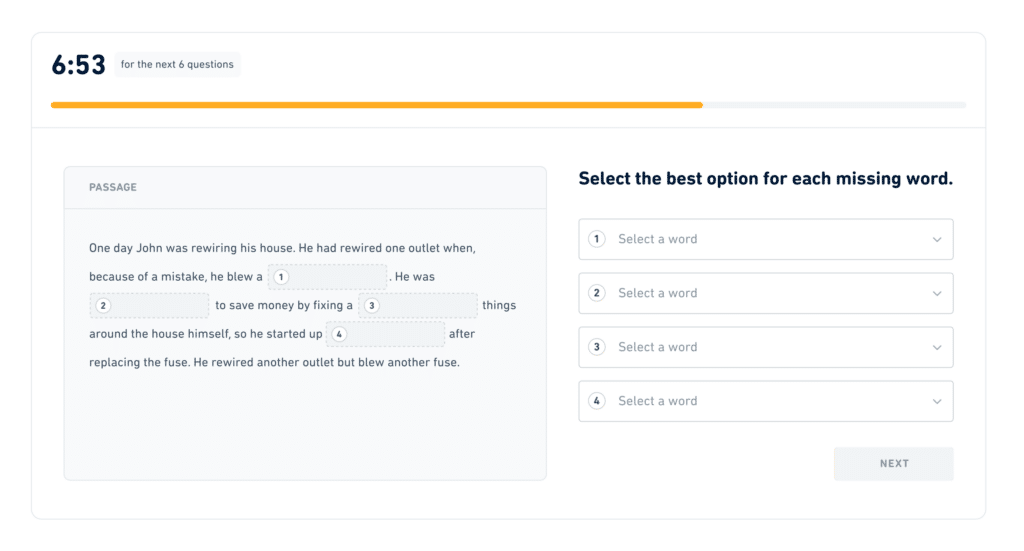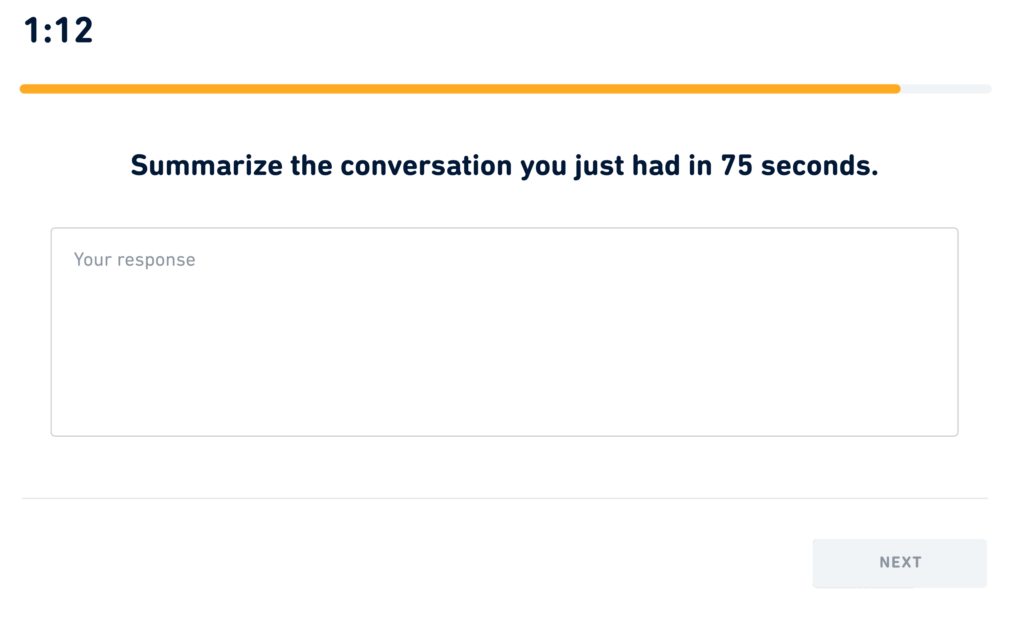The official Duolingo English Test site offers a free practice test that you can try here.
But wait!
Taking a practice test is only half the battle. You also need to learn about the structure of the test and how to study in a way that will help improve your score.
By the end of this short article, you will know how the Duolingo English Test is structured and how the question types will look. I will also share my top five tips for students studying on their own who need to improve their test score.
Let’s jump right in.
The Duolingo English Test structure
The TOEFL iBT® and IELTS® exams are organized based on sections. In the TOEFL iBT®, for example, you begin with the Reading, and then move on to the Listening, Speaking, and Writing sections.
The Duolingo English Test® is a completely different experience.
The main organizing principle you must become familiar with is the question types and how frequently they show up on the exam. The first five question types show up between three to six times during the first half of the test.
Duolingo English Test Question Types |
|||
|---|---|---|---|
| Question Types | Frequency | Adaptive | Subscore |
| 01. Read and Complete | 4-6 | ◯ | Comprehension, Literacy |
| 02. Read and Select | 4-6 | ◯ | Comprehension, Literacy |
| 03. Listen and Type | 4-6 | ◯ | Conversation, Comprehension |
| 04. Read Aloud | 4-6 | ◯ | Conversation, Comprehension |
| 05. Write About the Photo | 3 | X | Literacy, Production |
Keep in mind, besides Write About the Photo, these question types are adaptive, so they will remain easy or become more difficult as you progress through the exam.
The next part of the exam will consist of Interactive Reading and Interactive Listening passages. Expect two short reading passages between 100 to 200 words. You will have seven or eight minutes to answer six questions about each passage.

The Interactive Reading will be followed by the Interactive Listening. This part will also consist of two passages. One passage will be a conversation between two students about something related to campus life, and the second passage will be between a student and a campus worker, usually a professor. You will participate in the conversation, answering five or six questions. After the given passage is finished, you will have 75 seconds to write a summary of the conversation.


Duolingo English Test Question Types |
|||
|---|---|---|---|
| Question Types | Frequency | Adaptive | Subscore |
| 01. Read and Complete | 4-6 | ◯ | Comprehension, Literacy |
| 02. Read and Select | 4-6 | ◯ | Comprehension, Literacy |
| 03. Listen and Type | 4-6 | ◯ | Conversation, Comprehension |
| 04. Read Aloud | 4-6 | ◯ | Conversation, Comprehension |
| 05. Write About the Photo | 3 | X | Literacy, Production |
| 06. Interactive Reading, 2 passages | 12 | X | Literacy, Comprehension |
| 07. Interactive Listening, 2 passages | 12-14 | X | Conversation, Comprehension, Literacy, Production |
The remaining question types involve extensive writing and speaking responses. These questions are not adaptive, and each shows up once, besides Listen, Then Speak, which may show up twice.
Duolingo English Test Question Types |
|||
|---|---|---|---|
| Question Types | Frequency | Adaptive | Subscore |
| 01. Read and Complete | 4-6 | ◯ | Comprehension, Literacy |
| 02. Read and Select | 4-6 | ◯ | Comprehension, Literacy |
| 03. Listen and Type | 4-6 | ◯ | Conversation, Comprehension |
| 04. Read Aloud | 4-6 | ◯ | Conversation, Comprehension |
| 05. Write About the Photo | 3 | X | Literacy, Production |
| 06. Interactive Reading, 2 passages | 12 | X | Literacy, Comprehension |
| 07. Interactive Listening, 2 passages | 12-14 | X | Conversation, Comprehension, Literacy, Production |
| 08. Interactive Writing | 1 | X | Literacy, Production |
| 09. Speak About the Photo | 1 | X | Conversation, Production |
| 10. Read, Then Speak | 1 | X | Conversation, Production |
| 11. Listen, Then Speak | 1-2 | X | Conversation, Production |
| 12. Speaking Sample | 1 | X | Conversation, Production |
| 13. Writing Sample | 1 | X | Literacy, Production |
You can find more information on these questions in Duolingo’s Test Readiness Guide.
Now you know about the question types!
Still, if you’re anything like me, it’s tough to imagine how these questions will be presented on test day. Keep in mind that you will encounter one question at a time and can expect between 35-40 questions on test day, excluding the Interactive Reading and Listening. The Interactive Reading will consist of an additional 12 questions, and the Interactive Listening is usually 12 questions as well, adding up to a total sum of approximately 60 questions. Below is a question flow example of a typical Duolingo English Test.
| DET Test Layout | |||||
|---|---|---|---|---|---|
| 1st | 2nd | 3rd | 4th | 5th | |
| Initial Comprehension | Comprehension | Interactive Comprehension | Production | Shared Production | |
| Read and Select* (15-18) |
Read and Complete* (3-6) |
Interactive Reading* (2) | Write About the Photo (3) | Writing Sample (1) |
|
| Fill in the Blanks* (6-9) |
Read Aloud* (3-6) |
Interactive Listening* (2) |
Interactive Writing (1) |
Speaking Sample (1) |
|
| Listen and Type* (6-9) |
Listen then Speak (2) |
||||
| . | Speak About the Photo (1) |
||||
| *adaptive questions | Read then Speak (1) |
||||
Note that this is just an example, and do not expect to encounter the questions in the same order on test day. Here are three of the most important things to keep in mind when preparing for the exam structure:
- Speak About the Photo; Read, Then Speak; Interactive Writing; Listen, Then Speak, Speaking Sample, and Writing Sample usually appear at the end of the test.
- Write About the Photo questions appear during the first half of the test and usually consist of three consecutive questions.
- Read and Complete, Read and Select, Listen and Type, and Read Aloud questions will appear approximately six times and adapt in difficulty depending on your performance.
If you haven’t done so already, I recommend taking a practice test over at the Duolingo English Test website or trying more free practice questions right here.
Five tips to improve your Duolingo English Test score
Tip #1 – Speak and write as much as possible
There are seven question types in the Duolingo English Test where you will have to produce your own speaking and writing responses:
- Write About the Photo
- Speak About the Photo
- Interactive Writing
- Read, Then Speak
- Listen, Then Speak
- Speaking Sample
- Writing Sample
The directions for each of these questions will inform you of the least amount of words you have to write or the least amount of seconds you have to speak. No matter what the minimum requirement is, aim for the maximum.
For all three speaking questions, you are instructed to speak between 30-90 seconds; aim for 90 seconds.
For Write About the Photo questions, write as much as possible in the 60 seconds you are provided.
For Read, Then Write questions, write as much as possible in the 5 minutes you are provided.
Part of your grade is based on your grammatical and lexical complexity. The more you write and speak, the more opportunities you will have to show a wide range of grammar and vocabulary. If you hurry through these questions and follow the minimum requirements, it will be difficult to earn a score higher than 120.
Tip #2 – Plan out your week
When you begin to prepare for the Duolingo English Test, you will find a ton of free and paid resources that you can use to prepare for the exam. All of these materials are extremely helpful, but overwhelming. It is confusing when you sit down at your desk and try to figure out where to start.
A quick fix is to take an hour out of your day on Sunday and plan out your week. People do this when they diet. They prepare their lunch for Monday to Friday on Sunday, store it in the fridge, and grab each day’s pre-prepared meal without thinking about it. Do the same for your studies.
Set the time, place, and materials you plan to use Monday through Friday so you know what to do each day of the week. And then take Saturday off; you’ve earned it.
Tip #3 – Challenge yourself
Search any of the following question types on YouTube, and you will find examples to practice. Remember, the Duolingo English Test contains four adaptive questions that become more difficult if you perform well at the beginning of the test.
- Read and Complete
- Read and Select
- Listen and Type
- Read Aloud
Do the harder questions. Seriously. Challenge yourself. When you practice with more complex problems at home, it will build your confidence and improve your performance on test day.
Tip #4 – Record your voice
Speaking and writing questions are the hardest to prepare for because they require feedback from someone, usually a teacher, which is why I recommend working with a Duolingo English Test instructor like this one.
However, many test-takers will prepare on their own, which is why it is critical that you record your voice when you practice speaking. After you record your voice, listen back to your response and identify one or two ways you can improve. After that, do the same response again.
Here is an example of the questions you should ask yourself after recording your own response.
Speak About the Photo Self-Grading Rubric |
|
|---|---|
| Questions | Notes |
| 1. Did I speak for at least 45 seconds? | |
| 2. Did I start by describing the foreground? | |
| 3. Did I provide additional details or inferences to expand on the foreground? | |
| 4. Did I give a description of the background? | |
| 5. Did I make at least two inferences in my response? | |
| 6. Did I provide enough descriptive words and specific vocabulary? | |
| 7. Did I speak at a natural and conversational pace for the majority of my response? | |
| 8. Did I have less than five vocal fillers (uh, um)? | |
| 9. What can I do next time to improve my score? | |
Tip #5 – Set up your testing environment
“Your test score could not be validated.”
You do NOT want to see this message on your score report. Unfortunately, this happens to a ton of students. Since the Duolingo English Test is a completely automated testing experience, there is extensive technology in place that tracks your eye movement, mouse movement, computer behavior, and room environment to ensure that you do not cheat when you take the exam.
Here are a few key points to keep in mind when you are setting you your testing environment for the Duolingo English test:
- Keep your eyes on the computer. If you look away for too long, it will invalidate your score.
- Do not have any other browser window open. If you try to navigate away from the test, it will invalidate your score.
- Take the test in a well-lit room. If you are ever in the dark, it will invalidate your score.
- Be sure you are alone in a quiet room. If there is too much background noise, it will invalidate your score.
- Check your microphone and Internet connection. If at any point your Internet connection drops off or your microphone does not work, it will invalidate your score.
- You are not allowed to use headphones during the test. Be sure your computer speakers work.
If you have made it this far, you are ready to take the practice exam for the Duolingo English Test. Take it here right now.
But what do you think? Are there any tips I missed that you believe would be helpful for students studying for the Duolingo English Test? Be sure to leave it in the comments below. I respond to all of them.
Good luck and see you in the next one. Don’t forget to claim your free practice test.









111 Comments
Ambili
It is very informative
Jamal
What about the information needed for the test? Should I improve my knowledge about any information around the world? Or is the test just focused only on the skills like the TOEFL?
Josh
Good question. Just focus on the skills. It’s an English proficiency test, not a knowledge test so just focus on your English 🙂
Arslan
Hi Josh, I have a question as a suggestion. Please give the answers for each question on practice tests, like the writing and reading sections.
Josh
Hi there and thank you for your suggestion. Just to let you know when you download the practice tests or take them on our site they include an answer key to each question. If there is one missing somewhere, please provide a link and let me know.
Maryam
Thanks for the advise but can i book a lesson with you at home
Josh
Hi Maryam and thank you for commenting. You can find information about our DET online classes here – https://tstprep.com/store/det/private-lessons-for-the-duolingo-english-test/. You can email to contact@tstprep.com if you want to know more about our classes or need further assistance.
Muhammad Yasin
Sir, the speaking section is very difficult for me. What should I do?
Josh
Hi Muhammad and thank you for your question. Well, there are a lot of things you could do depending on your current situation, speaking level, and financial resources. I think a good place to start is a Production Score Evaluation (https://tstprep.com/store/det-production-score-evaluation/) where you will meet with a teacher and get feedback on your speaking and writing.
Kamrun
Very informative
Mary
Hi Josh! I’m a teacher of English and I’m helping my student to get ready for the DET. He is having a hard time typing fast. So even if he knows what to say, he doesn’t have enough time to type it within the time limits.
What would you recomend?
Mary
Hi Josh! I’m a teacher of English, and I’m helping my student to get ready for the DET. He is having a hard time typing fast. So even if he knows what to say, he doesn’t have enough time to type it within the time limits.
What would you recommend?
Josh
Hi Mary and always great to hear from a fellow English teacher. I have worked with students in a similar situation before and in this case, they need less help with test prep and more help with typing speed. I would recommend a site that is designed to help improve typing speed (words per minute). There are plenty of free sites but when I often recommend is Key Hero. I will leave a link here for it. https://www.keyhero.com/
Anmole
Hi,
I took the test two times, but my score was the same both times. I need a 120 score, but I got a 100 score both times, so please help me increase my score on the test. Thank you
Josh
Hi there and thank you for your question. Which parts are you scoring lower on? How long did you study? How do you study? If you can send me an email at josh@tstprep.com with more details I can give you some more specific help.
Hina
Hey, I have a question related to listen and then type. If I would make one mistake in typing then is it considered fully wrong or not?
Josh
Good question Hina. Unfortunately, Duolingo does not release information about how the questions are scored, but I imagine there is a reduction for misspellings but I don’t think you would score a zero. This is just a guess though.
Misbah
Hi. I have no laptop or computer; I have just a cell phone. I can’t do practice and can’t take exams. Do you know any application or website where I could practice on mobile?
Josh
Hi there Misbah and I am sorry to hear about your issue. I believe you can use the website DET Ready. It’s a web app and should work on mobile. You just need an Internet connection. I hope that helps!
Peace
Hi there. I have been wondering if complaints are accepted once one is not content with his DET scores. Thank you
Josh
Hi there and thank you for your question. I’m not sure what type of complaint you mean. I will link out to the Duolingo English Test help desk, which deals with customer service, but if you have something else in mind just let me know. https://testcenter.zendesk.com/hc/en-us
Joel Nestor
Hello,
Please, can I get the same questions for the Duolingo practice test in the Duolingo real exam?
Regards
Josh
Hi Joel and thank you for your question. If you make a free account you will have access to about 100 free questions here at TST Prep. You can also take free practice tests at the Duolingo English Test official site. I would also recommend Luke’s DET Ready site, it’s pretty cheap and has a ton of practice. https://www.detready.com/
Amine
Hi, I scored two times 110 with subscores of
literacy:120
comprehension:115
production:95
conversation:95
My target score is 120 so would someone help me get this score?
Josh
Hi Amine and thank you for your question. It sounds like you need some help with the speaking, particularly Read, Then Speak, Listen, Then Speak, and Speak About the Photo questions. You might want to meet with a teacher and get some feedback on your speaking. I also just recently released a series of videos on one of my Youtube channels that helps address this issue. You might find this one helpful – https://youtu.be/qjeQACvdpKM – Still, working with a teacher is the fastest way to get customized support based on your specific needs, here is a link to a trial lesson – https://tstprep.com/store/toefl-trial-lesson/ (it says TOEFL but it also works for the Duolingo English Test)
Joy
Hi Josh, I have taken this test 3-4 times and am still gaining the same scores (90-95). What should I do?
Josh
Hi Joy and thank you for your question, I just made a video about this issue for the speaking that you can check out here – https://youtu.be/qjeQACvdpKM (production/conversation score). If you are struggling with all four sections of the test, then you need to build up your fluency, instead of focusing only on test prep. Refold has a great guide to help language learners at this link – https://refold.la/onboarding/?redirectURL=%2Fquickstart.
Steffy Demiyan Rana
Hi Josh… I have appeared two times for the Duolingo exam, but at both times, I scored 105. Please give some suggestions for that.
My scores are
Literacy: 105
Comprehension: 115
Conversation: 105
Production: 95
Josh
Hi there and thank you for your question. At this point, since you have taken the test twice, I assume you have heard a bunch of tips and tricks and have done a bunch of practice. If, after that, you still haven’t improved your score, you should work with a teacher to improve your speaking and writing (production and conversation scores). You can also work with a friend or tutor, but the point is that you need to speak and write and get feedback on your speaking and writing and work on your weaknesses through practice, feedback, and repetition.
Your literacy and comprehension scores have more to do with your general knowledge of English and vocabulary level. This will improve through increased exposure to English through extensive reading, extensive listening with targeted practice on specific vocabulary, and continued immersion in English.
This advice changes depending on the student and I get more specific with test-takers who we work with 1-1 but this is the general advice I can give based on your experience.
Abubakar
Can I use Duolingo for a professional license?
Josh
You should ask the license board. Requirements are different depending on the industry.
Ajith Kumar
Hi, I scored two times 100 with subscores of
Attempt 1:
literacy:100
comprehension:110
conversation:95
production:80
Attempt 2:
literacy:95
comprehension:105
conversation:105
production:95
My target score is 120 so would someone help me get this score?
Josh
Hi there and thank you for your question. As a piece of general advice, working with a teacher will help improve your production score (and a bit of your conversation score). This is based on what you write and what you speak, in other words, what you produce. What you produce is in your control. When you work with a teacher, you are able to improve your speaking and writing through practice and feedback.
Your literacy and comprehension score are based more on your lexical and grammatical knowledge. This is improved through continued immersion in English through reading and listening. This takes more time, but you can do it on your own in a way you enjoy (through video games, movies, books, etc.).
Since you have taken the test twice, I assume you know the tips, tricks, and strategies for the test. After you learn about these skills, and you still don’t get the score you want, the next step is to improve your overall fluency. An overall 20-point score boost will require working with a teacher to practice your speaking and writing along with increased exposure to reading and listening to English materials for at least two hours a day for three months or more.
I hope that answers your question.
Shawan Shawakhawat Hossain
Hi, Josh I have a question. I am practicing on Duolingo’s official website and I got an 85-130 score can you tell me what score I can get on the real test?
Josh
Hi Shawan and thank you for your question. My guess would be somewhere between those two scores, around 110. However, they give you that wide-score estimate for a reason. It is hard to predict how you will actually perform on test day since one practice test is a small sample size.
Sukhdeep Kaur Kaur
Hello, I tried twice Duolingo test and got the same grade 95 and I need 110, can you help me, please?
Overall: 95
Literacy: 100
Comprehension: 105
Conversation: 85
Production: 75
Josh
A good place to start is on the videos on the Youtube channel about improving your production score for speaking. https://www.youtube.com/channel/UCrSJW79A-yX3Sbo1J9q1KTA
Noza
Hi Josh, I have a question. I got a 65-125 score on the Duolingo practice test. Can you tell me what score I can get on the real test?
Josh
Hi Noza and thank you for your question. This is quite a huge score range. I would just go in the middle of that and predict your score on the actual test is around 90. Let me know how the test goes, I’m curious to see how the ranges align with reality.
Alpi
Hi, can I put on the headset while taking the Duolingo exam?
Josh
Good question! No, you can not.
Samy
Hello Josh, do you have any videos on the Duolingo test? If yes, please share the link.
Josh
Hi Samy, if you go to this link on Youtube, you can find some free videos I have made available publicly, the rest are in the paid courses. https://www.youtube.com/channel/UCrSJW79A-yX3Sbo1J9q1KTA
Joy
Hello Josh!
Recently Duolingo made some changes to their question types, such as interactive listening, speaking samples will be graded…etc. Could you give me some information about their subscore and grading, please?
Josh
Hi Joy,
Duolingo does not release the secret sauce, as it were. Thus we can’t tell you exactly one point for X and two points for Y. But as you said, there have been changes. The speaking and writing samples are graded, and the bulk of what you answer in these sections will link to your production score. Basically, the more you can speak and write correctly, the higher your production score will be. Grammar mistakes and misspellings count, but we don’t know how much for each mistake. However, here is a link that may help answer some of your questions 🙂
https://tstprep.com/articles/det/duolingo-english-practice-test-with-answers/
Marziyeh
Hi Josh, my native language is Persian (Farsi). I want to take the English test Duolingo for university entrance, I was learning the German language beforehand, and now when I want to play in Duolingo App to improve my English, as Farsi is not on the list of Duolingo, it evaluates my level of English in the situation I choose the German language as my first language, do you have any advice for me to have better English practicing in Duolingo app?
Thanks in advance
Josh
Are you speaking about the regular Duolingo app? The famous one for general language learning? If so, please understand that the Duolingo app is very different from the test. They are both made by the same company but basically, that is it. If you want to get better at the questions that will be on the test, you should find practice test questions. Please read more about the test here and then let us know if you have any questions.
https://tstprep.com/articles/det/duolingo-english-practice-test-with-answers/
https://tstprep.com/articles/det/your-beginners-guide-to-the-duolingo-english-test/
Tanzu
Hi Josh, can you tell me the predicted score in the real test? I scored 100/140 on the practice test.
Josh
Hi Tanzu, unfortunately, knowing your predicted score based on that range is impossible. Your final score will be based both on the number of words you produce and grammar but also on how good the ideas are. Do you logically present your opinion? Do you repeat the same idea too many times? Answers to these types of questions will determine your final score. The only way to know this is to meet with a teacher or by actually taking the test.
Vinay
Hi Josh, I took the Duolingo test 3 times, And 3rd time I got a 90 score.
Literacy: 90
Comprehension: 100
Conversation: 80
Production: 75
I want a 120 score or above. Can you give me any suggestions?
Josh
Thank you for your question. It is impossible to give specific advice without meeting a student, but generally, a 75 production score indicates your need to focus more on speaking and writing. The production scores are heavily tied to Speak About the Photo, Read and Speak, Speaking Sample, Write About the Photo, and Writing sample. In essence, you need to be able to produce, i.e., say or write enough words during the allotted time. If this is hard for you, it might be worth considering some private classes, but understand the type of score increase you are asking about will take a lot of time and practice.
Asad
Hi Josh. Does it have to be built-in speakers for the laptop or computer we must use? Are no earphones or Bluetooth acceptable?
Josh
Hi Asad, I understand that any device that goes into your ears is unacceptable, but please confirm this with Duolingo as they continue to revise the exam.
Stasiaex
Hi Josh, are there exclusive treatments for the use of earplugs for people that have hearing challenges?
Josh
Hi Stasiaex,
You will need to check with Duolingo directly about this question. This is because special accommodations may vary on a case-by-case basis.
Parth
Hello, I took three exams and scored 105, but I am stuck on the production score. I need 90 to get an admission, but I am getting 80, so what can I do to get more than 10 points in the production section?
Josh
Good question! To improve production you mainly want to focus on speaking and writing. Try reading this great article. I think it will help you. https://tstprep.com/articles/det/the-duolingo-english-test-writing-section/
Shehani Perera
Hi Josh
I have a problem with my connection. Is it okay to use Dongle? Because I don’t have a WiFi Connection.
Please reply
Josh
Thanks for the question. I am not familiar with Dongle. Please check with DET directly to see if they will allow it.
Nikhar
Hi sir, I took the exam 4 times, but it’s still an invalid test.
1) look away
2) security
3) security
4) writing error
How can I get a result?
I am feeling very stressed because of the invalid test. What can I do?
Josh
Hi Nikhar, you would need to check with Duolingo directly to see what is causing these errors.
Joana
Hello, is a microphone compulsory or can we speak without one?
Josh
Hi Joana, the test conditions for DET are subject to change, so it is best to contact DET and ask them directly to make sure you have the most up-to-date information.
Taha
Hi Josh,
I took the DET practice test but I was under the impression that they would give you with a predicted score in the end. They don’t, do they?
Josh
Hi Taha, it depends on what site you took the practice test. Can you give me more information about where you took the test? Also, please keep in mind that the DET practice tests will give you a huge range of predicted scores because no person is listening to your speaking or checking your writing, so I don’t find them very helpful.
Mujtaba
Hello
How is the overall score calculated?
For example, I got 105, 120, 125, and 135 in all four parts, and my overall score was 125. If We sum all of them and divide by four, it doesn’t equal 125.
Josh
Hi,
The scores are not averaged equally. Some categories, like production, count more towards the overall score. For more information, you can check out this great article on the test. https://tstprep.com/articles/det/your-beginners-guide-to-the-duolingo-english-test/#good-score
Farbod
Hi Josh, this article is fantastic. I was stunned when I saw this much information on these beautiful, well-shaped tables. I appreciate your efforts. Good luck. Also, keep up the good job👍🏻
Malalai Stanakzai
Hello
I took two times DET but both of them wasn’t accepted and told me you were with through from camera, but I was in my specific place in front of camera and I want to ask that I will take it for the third time I don’t know how I can take points and acceptance because according to all guidance, I saw to screen and no problem Was there. If you have any guidance to pass my this test to accepted please tell me.
Josh
Hi Malalai, We provide test-taking strategies for the DET, but TST Prep does not administer the test. As such there is no way for us to tell what the technical problem was. I strongly suggest contacting the DET customer service and explaining your situation. Ask for specific advice as to how you can avoid this problem the third time.
Solomon
Are Speaking and Writing still not contributing to the final grade?
Josh
Speaking and Writing certainly do contribute to the final grade. The main area where this is reflected is in the production score. I hope this answers your question, but if not, please feel free to clarify.
Kawchar
I took the Duolingo test once. But i got only 90 score. But I need 120. So how will I get a good score?
Josh
Thank you for your question. It is difficult to know what areas you need to work on without seeing your test results broken down by category. Please consider doing a trial lesson with us so we can go through your test together and maybe make a plan.
Soma
Hey Josh,
I took the exam three times at 1st one I got 90 the 2nd was 95 and the last one was 100. I need much higher score especially in the production sub score. Any advice?
Hashem
Hi teacher Josh,
I had a problem with the Duolingo practice test. I always get 95-135 or 85-135; my last attempt was 80-130, even though I write more than 100 words and speak more than 1 minute. What do you suggest to do to increase my score on the practice test?
Sara
Hi Josh, I took the test, but my results were not certified. It says it’s invalid because it was evident that I was reading a response that had been written out. However, I located a mirror behind me to display that there is no paper, and I follow the rules. Should I retake the test, and if yes, what should I prevent invalid result like this. Or should I contact Duolingo and explain my situation?
Also, in my free practice, I scored 110-145. What would be my estimate overall score on the real test? I need a minimum of 120 overall.
Josh
Hi Sara,
Thanks very much for your question. We mainly teach test strategy but have no way of knowing how and why Duolingo may decide to invalidate your score. The best thing to do is contact Duolingo directly and explain your situation. Ask them explicitly how they came to the conclusion you were reading and how you can avoid this in the future. They are in a much stronger position to give you advice than we are. Hope this helps.
Vinay
Hello Josh,
I took exam 4 times, In that i got 3 time invalid and 1 time i got 90 score. Still iam practising test and iam getting 95 score, Shall i start real exam?
Eyasu
I cannot sign up. It says already registered, but I am new here.
Josh
Are you talking about our tstprep.com website? If so, please look back in your email for a username and password, If you still can’t gain access, please send an email to contact@tstprep.com.
Vishal
Do I need to turn on the microphone throughout the test? And is the first letter compulsory to be capitalized?
Josh
Hi, thanks for the question. Yes, the microphone must be on. If you are asking about the first letter of a sentence, then yes, it must be capitalized.
Angel
Hello. I wanna know if the laptop’s installed microphone is enough or if I should plug in an extra. I’m planning on taking the Duolingo test by the end of this week so please answer me as soon as you can.
Josh
Hi Angel, Thanks for reaching out. For technical questions, especially about sound, you need to check with the test company directly. I believe they may offer a sound test on your device.
Sunita Thapa
Josh, good morning. I got 85 – 95 on the practice test. What does it mean? I mean, My level in the test?
Josh
Thanks for your question. 85-95 is giving you a general range, but this does not mean this will always be your score. Practice tests can often differ wildly from real results. If you do score in this range, it means your level of English would be classified as intermediate. Hope this helps. 🙂
Hope
Sir, I would love to ask what the overall score you need to pass the DET is exactly?
Josh
Thank you for your question. There is no set score. The institution you are applying to will set its own guidelines. Please make sure to check with them. Thank you 🙂
Banin
Hello, could you please respond me that what is my level? I received 90-110 in the free Duolingo English test.
Josh
Hi Banin, Thanks for your question. It is important to say that a practice test won’t always give accurate results, especially with speaking. That being said, your score would suggest your level of English is somewhere between intermediate and upper intermediate.
Brittany
Hi, I have two questions about the Duolingo Test from a student. I was wondering whether you can help… Will you be penalised for not using American English (colour/color, organised/organized)? Are there any concessions to help a student with dyslexia? I would really appreciate your response or the contact of someone I can ask.
Josh
Thank you for your questions. My understanding of both American and British English will be considered correct, I believe there are accommodations for students with certain special needs. The best course of action would be to contact Duoling and ask them what documentation you would have to provide.
Anjan
Hi Josh,
I have taken your Udemy course and completed all modules, but I was stuck with a 105 score. However, I need 120 overall, which I need to improve my score within a shorter duration; additionally, I got a conditional offer, so I need to submit my score to the university. Please guide me to where I’m lagging, and please inform me if you’re doing any crash courses for this test or if anyone is doing it. I appreciate your response; thanks in advance.
Josh
Hi Anjan, thanks for your question. Sorry to hear are having trouble getting to 120. The best suggestion would be to do a 30 minute evaulation with us. This way, it might be easier to see which part of the test you need to focus on.
Meseret
I took the Duolingo test, but I didn’t get a scholarship. Please, help me!
Josh
Hi Meseret. I would suggest doing a Duolingo evaluation with us so we can see how to best help you.
Cyuzuzoterry
If my Duolingo results are not certified, can l retake the test within 21 days of my original purchase?
Josh
Thanks very much for your question. I am not sure of Duolingo’s policy in this situation. I would suggest you contact them directly.
Mambu Alex Kenni
I want to take the Duolingo exam. What will the criteria be?
Josh
Hi Mambu, Thank you for your question. This article should give you the basic criteria.
https://tstprep.com/articles/det/your-beginners-guide-to-the-duolingo-english-test/
Joan Essien
Thank you, sir, for your tips. They are really helpful. Please, I am from Nigeria. How can I register for the test?
Josh
Hi Joan, do you mean the real test or the free practice test? For the real test, you have to register with ETS. You can get the free practice test at https://tstprep.com/articles/toefl/complete-practice-test-for-the-toefl-test/.
Zyyada
Hi!
I am currently at 100 points. Is it possible to bring it to 130 in a month?
Is there a teacher who can prepare for the Duolingo test?
Josh
Hi Zyyada and thank you for commenting. We offer DET courses, practice resources, and classes with experienced DET tutors on our site here – https://tstprep.com/store/det/. You can always reach out at contact@tstprep.com if you have any questions about practice materials or private lessons.
Maryam
Hi josh i am not in very good condition in that writing section please help me
Josh
Hi Maryam, thank you for commenting. You can find useful tips on our site here – https://tstprep.com/articles/det/. If you need additional help and guidance, you may consider working with a teacher. Here is a link to our private classes if you are interested – https://tstprep.com/store/det/private-lessons-for-the-duolingo-english-test/.
Sajad
Hi josh and thank you for the great work you do here for test-takers. It really helped me to find a solid understanding of the real test day. I have recently taken Doulingo free practice test and got 125 – 130, and I wonder if the estimation that the practice test gives me is accurate. Above 120 score in Doulingo real test is sufficient for me, but my concern is that what if the estimation provided at the end of practice test is not accurate and I can’t get higher than 120 in real test.
As you have had the experience of working with so many test-takers, could you possibly clarify my concern.
Thank you from the bottom of my heart.
Josh
Thank you for your question. In general, the practice tests give an approximate sense of your possible. They are generally accurate. However, because no human being grades the speaking and writing parts of the practice tests, your results can vary either higher or lower. The only way to really know is to take the test.
Exam Help Services
Very interesting stuff to read.
Josh
That’s very kind of you to say, thank you.